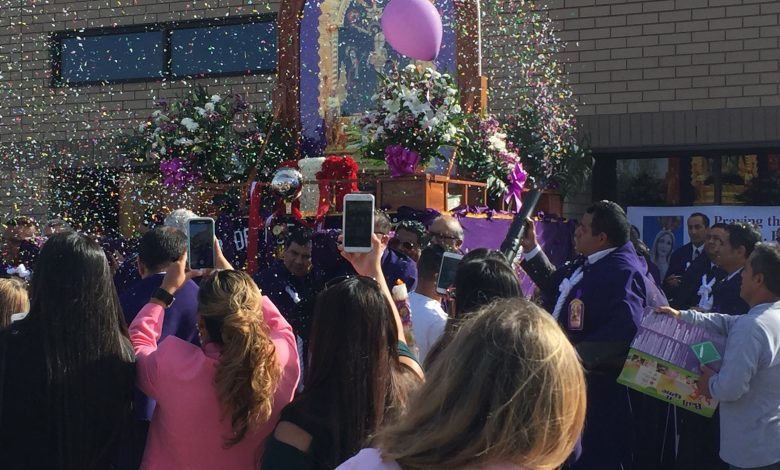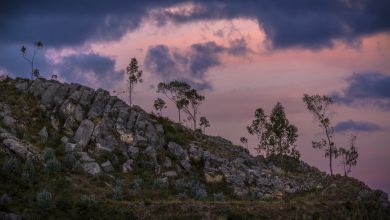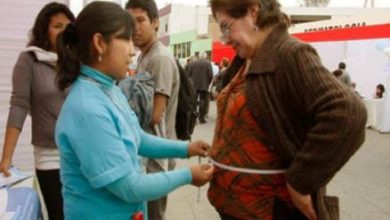A Procession of the Lord of Miracles in Utah

The poster on the door of the Peruvian shop announced in bold letters Procesión del Señor de los Milagros. It was intriguing, and I picked up a flyer, which announced the date as October the 15th at a small church in the west of Salt Lake Valley.
At the register we asked about the procession and were told there were a couple more in the area organized by different hermandades, brotherhoods. At the side of the register, they offered a Peruvian treat, a Turrón de Doña Pepe. She was an African slave who received the recipe in a dream after she was cured of paralysis.
Wanting to experience the day correctly, I purchased the turrón and made plans to arrive for the procession. The treat was indeed a dream of flavours.

I also wanted to know more about this wonderful celebration from Peru, so I started reading. In about 1650 an Angolan man painted an image of Christ on the adobe walls of the brotherhood of Señor de los Milagros. He belonged to a group of Africans forcibly brought to Peru who later settled in the Pachacamilla district. They lived in abject poverty, with little time for celebration. Through the brotherhood they worked together to help the sick and bury the dead.
We found the church and parked the car. Just outside the building was a covered litter, festooned with flowers and balloons and replete with beautiful embroidered emblems.

In 1655, an earthquake leveled the Pachacamilla district, however the wall with the painting of Christ remained intact. For fifteen years the wall stood among the ruins alone. Then Antonio Leon found the image and was amazed at its perfection after so many years of neglect. He cleared away the debris from the fallen house and set up a small altar. Angolans returned, along with other black people from the neighbourhood. This was their altar, their shrine. They gathered and played music and sang songs to Christ.
People came to this Utah church festively dressed, and everywhere purple was in evidence. There were people in suits, soccer jerseys, and some wore purple robes, marking them as adherents to the brotherhood.

Concerned that the image was not in keeping with Catholic canon, the archbishop and civil leaders decided that it should be painted over. A team was sent out, including soldiers, to make sure that there were no protests from the locals as the painting was obliterated. The first man up the ladder to paint over the relic became quite ill. A second went up the ladder and said he felt the painting became so beautiful that he was unable to fulfill his duty. When the painters were thwarted, the people drove the soldiers away. The Viceroy changed his mind and allowed the people to venerate the image. In 1671 the first mass was held in front of the image.
Mass was intoned in Utah. I could hear the priest blessing all those who attended. The rising and seating of bodies. The chapel was beautiful appointed and purple draped the altar.
In October of 1678 another earthquake rocked the area of Lima and the building housing the image was destroyed, yet, by a miracle, the painting survived. A three dimensional replica of the painting was created and carried through the streets. It was the birth of the procession. This was done in October each year.
The church disgorged purple clad people into the parking lot. These men – the cargadores gathered near the litter. There was anticipation in the air, as thick as the confetti blown by a leaf blower to cover their heads and shoulder with a cloud of color. The purple and white balloons bobbed. The music started.

The brotherhood has changed over the years marking major mile stones. Devotion to the Lord of Miracles spread throughout Peru. The Catholic church officially recognized the Brotherhood of the Lord of Miracles de Nazarenas, and a hymn was chosen for the event, adding a canonized music to the ritual. According to Julia Costilla in “Una práctica negra que ha ganado a los blancos: símbolo, historia y devotos en el culto al Señor de los Milagros de Lima,” published in Anthropológica, “brothers came mostly from unions, adoberos, coachmen, port stevedores, etc., (but increasingly) were incorporated progressively professionals, executives, officials, government ministers, officers of the armed and police forces and sports figures, arts and movie stars”. She also observes that over time, there were other changes among the worshipers. The white Christ was originally painted by a black man and venerated by a group of black men, the image slowly began to darken from all the candles that had been burned before it. As the image darkened, the adherents to the Brotherhood changed from predominately black to more mestizo and European.
In the parking lot, the sahumadoras gathered their incense burners and led the way through the crowd. They were followed by girls bearing candles. The bell sounded and the procession moved through the parking lot as the music played. At stops, children were lifted to kiss the face of Christ.
This Lord of Miracles had made a miraculous journey to arrive in Salt Lake, and many other cities and towns throughout the world. The first appearance of the procession outside of Peru was in Hartford, Connecticut. The festival was held among Peruvians to celebrate their culture. As of 2013, the celebration of Senor de los Milagros is held in 24 countries worldwide, including such foreign shores as Japan and Italy. It has also found its way to Africa.
The festival moved on. The people sang and followed the image. I smiled and turned as I felt I had looked not only into the past, but into the future.




